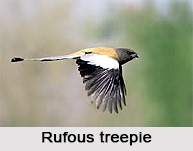 Rufous Treepie is an Indian bird that bears a scientific name "Dendrocitta vagabunda", is a long tailed bird from the corvus family. It is a member of the crow family, Corvidae.
Rufous Treepie is an Indian bird that bears a scientific name "Dendrocitta vagabunda", is a long tailed bird from the corvus family. It is a member of the crow family, Corvidae.
Concentration of Rufous Treepie
Rufous Treepie is a Treepie, native to the Indian states and adjoining parts of Southeast Asia.
Structure of Rufous Treepie
Rufous Treepie is long tailed and has loud musical calls making it very conspicuous. It is found commonly in open scrub, agricultural areas, forests as well as urban gardens. Like other corvids it is very adaptable, omnivorous and opportunistic in feeding. In Bengali and some other Indian languages it is called "Harichacha" after the unpleasant sound it produces.
Sexes of Rufous Treepie
The sexes of Rufous Treepie are alike and the main colour of the body is cinnamon with a black head and the long graduated tail is bluish grey and is tipped in black. The wing has a white patch. The only confusable species is the grey treepie which however lacks the bright rufous mantle. The bill is stout with a hooked tip. The under parts and lower back are a warm tawny-brown to orange-brown in colour with white wing coverts and black primaries. The bill, legs and feet are black.
Population of Rufous Treepie
The widespread populations of Rufous Treepie show variations and several subspecies are recognized. The nominate subspecies is found in the north eastern part of peninsular India south to Hyderabad. The desert form is paler and called pallida, vernayi of the Eastern Ghats is brighter while parvula of the Western Ghats Mountain Range in India is smaller in size. The form in Afghanistan and Pakistan is bristoli while the form in southern Thailand is saturatior. E C Stuart Baker describes sclateri from the upper Chindwin to the Chin Hills and kinneari from southern Myanmar and northwest Thailand. The population in eastern Thailand an Indochina is sakeratensis.
Habitat of Rufous Treepie
The range of Rufous Treepie is quite large, covering all of mainland India up to the Himalayas, and south-easterly in a broad band into Burma (Myanmar), Laos, and Thailand in open forest consisting of scrub, plantations and gardens.
Feeding of Rufous Treepie
Rufous Treepie is an arboreal omnivore feeding almost completely in trees on fruits, seeds, invertebrates, small reptiles and the eggs and young of birds. It has also been known to take flesh from recently killed carcasses. It is an agile forager, clinging and clambering through the branches and sometimes joining mixed hunting parties along with species such as drongos and babblers. It has been observed feeding on ecto-parasites of wild deer. Like many other corvids they are known to cache food. They have been considered to be beneficial to palm cultivation in southern India due to their foraging on the grubs of the destructive weevil Rhynchophorus ferrugineus. They are known to feed on the fruits of Trichosanthes palmata which are toxic to mammals.
Breeding of Rufous Treepie
The breeding season of Rufous Treepie in India is April to June. The nest is built in trees and bushes and is usually a shallow platform. There are usually 3-5 eggs laid.
Call of Rufous Treepie
Rufous Treepie has a wide repertoire of calls, but a bob-o-link or ko-tree call is most common. A local name for this bird kotri is derived from the typical call while other names include Handi Chancha and taka chor in Bengali language.



















